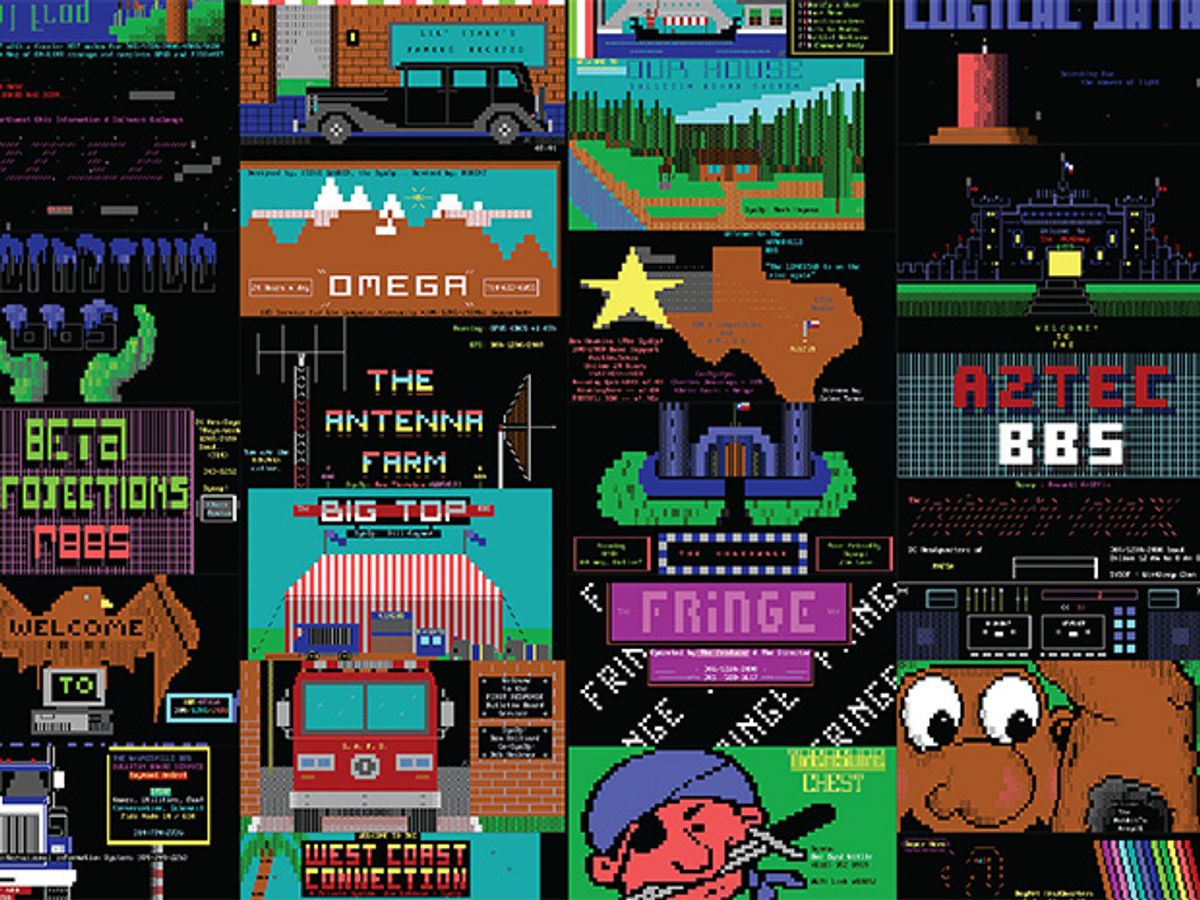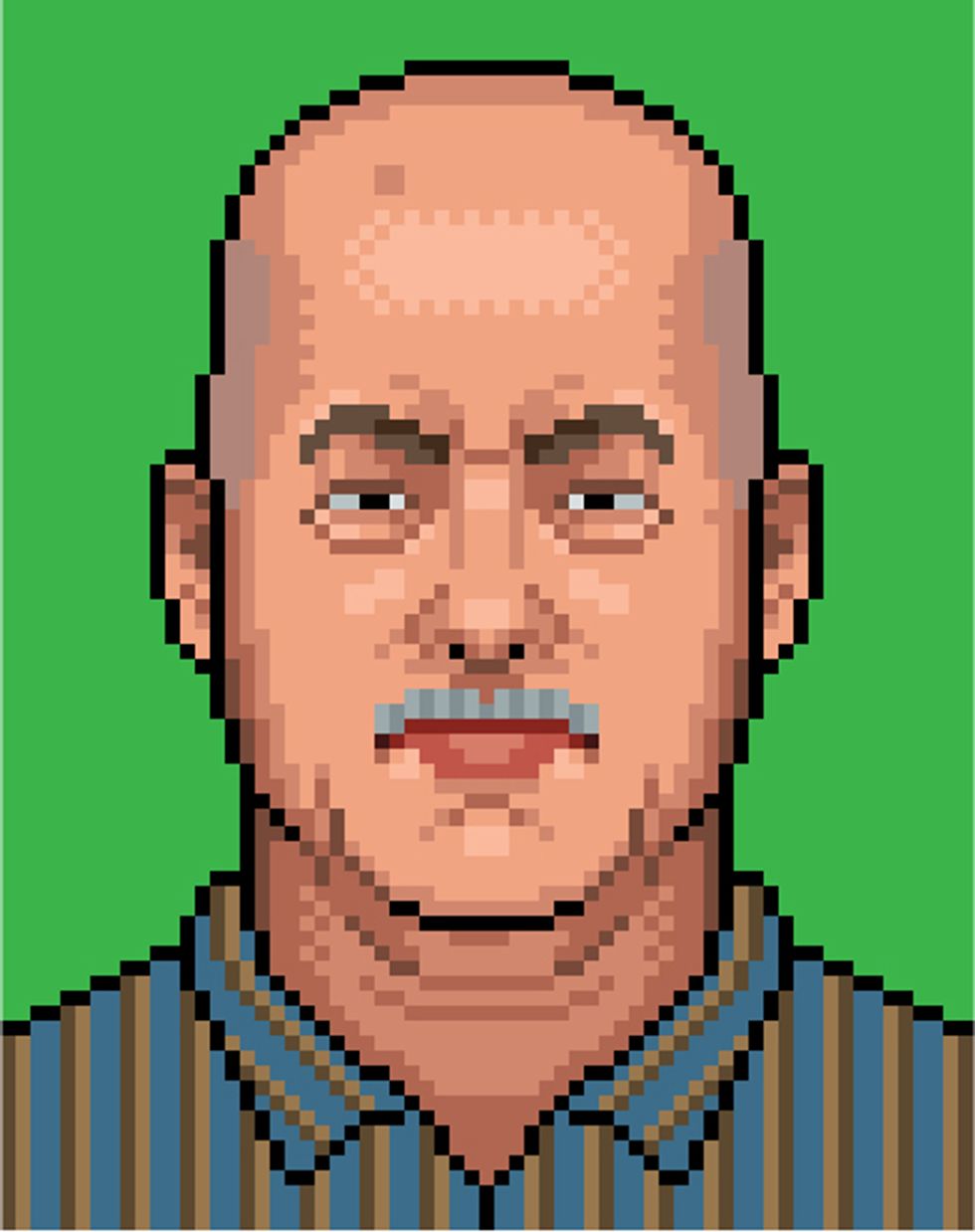Social Media’s Dial-Up Ancestor: The Bulletin Board System
The history of the BBS shows that pre-Internet social media was pretty great

For millions of people around the globe, the Internet is a simple fact of life. We take for granted the invisible network that enables us to communicate, navigate, investigate, flirt, shop, and play. Early on, this network-of-networks connected only select companies and university campuses. Nowadays, it follows almost all of us into the most intimate areas of our lives. And yet, very few people know how the Internet became social.
Perhaps that’s because most histories of the Internet focus on technical innovations: packet switching, dynamic routing, addressing, and hypertext, for example. But when anyone other than a network engineer talks about the Internet, he or she is rarely thinking about such things. For most folks, the Internet is principally a medium through which we chat with friends, share pictures, read the news, and do our shopping. Indeed, for those who’ve been online only for the last decade or so, the Internet is just social media’s plumbing—a vital infrastructure that we don’t think much about, except perhaps when it breaks down.
To understand how the Internet became a medium for social life, you have to widen your view beyond networking technology and peer into the makeshift laboratories of microcomputer hobbyists of the 1970s and 1980s. That’s where many of the technical structures and cultural practices that we now recognize as social media were first developed by amateurs tinkering in their free time to build systems for computer-mediated collaboration and communication.
For years before the Internet became accessible to the general public, these pioneering computer enthusiasts chatted and exchanged files with one another using homespun “bulletin-board systems” or BBSs, which later linked a more diverse group of people and covered a wider range of interests and communities. These BBS operators blazed trails that would later be paved over in the construction of today’s information superhighway. So it takes some digging to reveal what came before.
How did it all start? During the snowy winter of 1978, Ward Christensen and Randy Suess, members of the Chicago Area Computer Hobbyist’s Exchange (CACHE), began to assemble what would become the best known of the first small-scale BBSs. Members of CACHE were passionate about microcomputers, at the time an arcane endeavor, and so the club’s newsletters were an invaluable source of information. Christensen and Suess’s novel idea was to put together an online archive of club newsletters using a custom-built microcomputer and a hot new Hayes modem they had acquired.
This modem included an auto-answer feature, to which Christensen and Suess added a custom hardware interface between the modem and the hard-reset switch. Every time the telephone rang, the modem would detect the incoming call and then “cold boot” their system directly into a special host program written in Intel 8080 assembly language. Restarting the system with every call offered a blunt but effective means of recovering from hardware and software crashes—a common occurrence on home-brew hardware of the time.

Once a connection was established, the host program welcomed users to the system, provided a list of articles to read, and invited them to leave messages. Christensen and Suess dubbed the system “Ward and Randy’s Computerized Bulletin Board System,” or CBBS. It was, as the name suggested, an electronic version of the community bulletin boards that you still see in libraries, supermarkets, cafés, and churches.
Anyone with access to a teletype or video terminal could dial into CBBS. And after a few months, a small but lively community began to form around the system. In the hobbyist tradition of sharing information, Christensen and Suess wrote up a report about their project titled “Hobbyist Computerized Bulletin Board,” which appeared in the November 1978 issue of the influential computer magazine Byte.
The article provided details about the hardware they used and how they organized and implemented their software. The authors even included their phone numbers and invited readers to take CBBS for a spin. Acknowledging the experimental nature of the system, they encouraged readers to “feel free to hang up and try several times if you have problems.” After the issue hit newsstands, calls to their computer started pouring in.
Over the next few years, hundreds of small-scale systems like CBBS popped up around the country. Perhaps inspired by the Byte article, many of these new systems were organized by local computer clubs. In 1983, TAB Books, publisher of numerous DIY electronics guides, published How to Create Your Own Computer Bulletin Board, by Lary L. Myers. In addition to explaining the concept and motivation behind online services, Myers’s book included complete source code in the BASIC programming language for host software. The back of the book also listed the telephone numbers of more than 275 public bulletin-board systems in 43 U.S. states. Some charged a nominal membership fee, while most were free to use. The roots of social media were beginning to take hold.
In retrospect, 1983 proved to be a critical year for popular computing. In France, the state-sponsored Minitel system completed its first full year of operation in Paris, making online news, shopping, and chat accessible to every citizen in that city. In the United States, novel commercial systems gained traction, with CompuServe reporting more than 50,000 paying subscribers.
Even Hollywood took interest in cyberspace. The 1983 movie WarGames, featuring a teenage hacker who explored remote computer networks from his bedroom, became an unlikely box-office smash. Although the IMSAI microcomputer and acoustic-coupler modem depicted in the movie once cost as much as a cheap used car, curious computer users inspired by the film could buy serviceable alternatives at the nearest Radio Shack for roughly the cost of a good-quality hi-fi stereo. And as the decade progressed, the online universe expanded rapidly from its original core of microcomputer hobbyists to encompass a much wider group.
Early dial-up BBSs were mostly local affairs. And no wonder: In the early 1980s, most Americans paid a flat monthly fee for unlimited local phone calls, but calls to another city or state were billed according to duration, distance, and time of day. Even calls within the same state could be quite costly. For tenderfoot BBS users, running up a monstrous phone bill was considered a rite of passage. To avoid long-distance calling altogether, more seasoned users restricted their online activity to nearby systems that could be reached toll free.
The local nature of BBSing meant that users could reasonably assume that the people they met online lived nearby. Even though many BBSs encouraged the use of pseudonyms, or “handles,” it was entirely possible that the person you were chatting with online tonight could be bagging your groceries or coaching your daughter’s soccer team tomorrow.
Many BBS administrators, or “sysops,” reinforced this sense of community by hosting regular in-person get-togethers, often at local parks or favorite watering holes. Online disagreements—flame wars—could be kept in check as well, because the cost of being a jerk escalated with the likelihood of later seeing your interlocutor face to face.
Another key distinction between the dial-up BBSs of the early 1980s and the social media services we use today is that, for the most part, each BBS was a world unto itself, whirring away in blithe isolation from all others. Over time, each system developed its own idiosyncratic personality. One might focus on trading shareware games, another on arguing politics, and a third on talking about TV shows.

Experienced BBS users would visit the various systems in their areas, maintaining a separate profile on each one. In big metro areas like Atlanta, Minneapolis, or Houston, there might be a dozen or more local BBSs to tap. But folks in less populated areas were seldom so lucky. Rural users with particularly narrow interests—say, collecting antique clocks—may have had only one or two other people nearby to chat with. They longed for more.
To overcome the economic cost of long-distance calling and the social cost of isolation, BBS operators needed to find a way to interconnect their systems, to create a network of BBS networks—a people’s Internet. Christensen and Suess had floated the idea of a network of BBSs in the conclusion of their 1978 Byte article, but it was fellow amateur Tom Jennings who designed a real inter-network of BBSs.
In 1984, Jennings was distributing free of charge from his home in the San Francisco Bay Area a BBS host program for Microsoft’s operating system, MS-DOS. He called the program Fido. The popularity of the Fido BBS grew alongside that of MS-DOS, and soon there were a dozen or more BBS systems running the program.
On a lark, Jennings added an experimental feature to his software that enabled two Fido BBSs to call each other automatically and exchange data. After a coast-to-coast test with John Madill, a Fido BBS operator in Baltimore, Jennings organized the first network of BBSs and called it FidoNet. Within a decade, FidoNet grew into a massive 20,000-node network reaching users as far away as South Africa and New Zealand. Unlike with today’s Internet, machines on this network would typically store data for many hours before forwarding it on to its destination. But FidoNet nevertheless functioned as a valuable global data network.
The early versions of FidoNet included a number of clever design decisions that facilitated the rapid growth of the network. From the start, for example, Jennings encouraged collaboration by publishing technical documentation on FidoNet’s protocols and file formats. As a result, support for FidoNet was added to other BBS-software packages and soon became a de facto standard for building such networks.
Because FidoNet was run primarily by hobbyists, it was designed to keep costs down. Exchanges between nodes normally took place in the middle of the night, when long-distance phone rates were lowest. This interval, during which many BBSs refused to answer calls from users, became known to insiders as “national mail hour.”
Initially, FidoNet provided only inter-BBS email services. But FidoNet allowed BBS users to imagine themselves contributing to a vast conversation with people from all over the world. Newcomers later added other features and capabilities.
In 1986, Jeff Rush, a BBS operator in Dallas, created a conferencing mechanism for FidoNet. Rush’s system, dubbed Echomail, worked similarly to the forums on CompuServe or the newsgroups on Usenet: You could post a comment, and anyone on the network could reply to it. But participation in those earlier forums required either a costly monthly subscription or access to a public Unix system, whereas anyone with a PC and a modem could access FidoNet’s Echomail. As a result, Echomail became hugely popular and was particularly useful for people living in rural areas or those with niche interests. For the first time, the whole population of BBS users could engage in discussion together.
Beyond the United States, BBSs seemed to spring up anywhere that a microcomputer could be connected to a telephone line. In 1987, Pablo Kleinman, a sysop in Buenos Aires, helped to connect the first four FidoNet nodes in Argentina, and a year later, Juan Dávila, a sysop in Puerto Rico, announced the creation of Latino Net, a Spanish-language conference. Following the dissolution of the Soviet Union in 1991, a FidoNet user based in the United States circulated technical information about reading and writing Cyrillic messages and encouraged fellow FidoNet enthusiasts to reach out to the “overwhelming” number of Russian users joining the network.
By 1993, Randy Bush, a long-time advocate of FidoNet in the developing world, estimated that 59 percent of the nodes were located in North America, 30 percent in Europe, 4 percent in Australia and New Zealand, with the remaining 7 percent split among Asia, Latin America, and Africa. The African systems may have been small relative to the whole network, but these small networks could have an outsize impact for local users. In some regions of Africa, noted Bush, a FidoNet gateway provided an important means for poorly funded academics and NGO staffers to keep up to date with the latest research and news from abroad.
The growth of FidoNet during the 1980s was part of a larger movement toward greater connectivity among computer networks. Those interconnections were made using special gateways that translated messages between otherwise incompatible networks. In 1986, the administrators of several institutional Unix systems opened gateways to nearby BBSs, thereby enabling the exchange of messages among users of FidoNet, Usenet, and the nascent Internet. Indeed, several Usenet newsgroups began as automatically created copies of material posted in popular FidoNet Echomail conferences.
It’s tempting to imagine that these gateways introduced BBS users to the Internet. But the Internet at that point held no particular appeal for most BBS users, who were already enmeshed in their own lively online worlds. The early Internet was limited to people with access to a large university or research center, whereas BBSs were open to anyone. As a result, they could be wacky and weird—independent free agents in cyberspace. Indeed, it may be more accurate to say that gateways exposed the relatively staid Internet to the wild ways of BBSers.
As the 1980s passed into the 1990s, falling prices for computers as well as the availability of used PCs allowed many more people to start using the technology. Modems also shifted from an expensive option to a standard component on new PCs. As these barriers to participation fell, a wave of new recruits came online, and the culture of BBSing began to reflect their more diverse interests. Teens, educators, artists, and entrepreneurs joined the growing population of BBS hosts and users.
Hundreds of BBSs appeared in the late 1980s and early 1990s to serve particular communities and interests. The Batboard in Columbia, Mo., was dedicated to all things Batman, for example, while the Complete Baseball BBS in Cambridge, Mass., featured a different sort of bat. Followers of the Grateful Dead (“deadheads”) arranged tape trades and carpooling on the WELL in Sausalito, Calif., and hard-core gamers exchanged homemade Doom levels on Software Creations in Clinton, Mass. The Back Door in San Francisco supported a lively LGBT community, while the Backdraft in Key Largo, Fla., provided a meeting place for firefighters. The Christian-themed Winplus in Kent, Wash., and the pagan-oriented Brewer’s Witch in Houston were both well known for their friendly off-line get-togethers, while DharmaNet linked up hundreds of Buddhist BBSs.
Free from the staggering size and profit imperative of commercial services, such small-scale community-oriented BBSs were sites of experimentation. Given the preponderance of men in the early BBS culture, many sysops endeavored to create welcoming environments for the relatively few women who called in. Stacy Horn, proprietor of the long-running Echo BBS in New York City, was especially tenacious in her appeals to women, offering new female users 12 months of free service and women-only online conferences. “I thought it would be a cooler place if there were women there,” she remarked in an interview from 1996. “Who cares to talk to 20-year-old white guys all the time?”
Unlike with social-media services today, it was common for small-scale BBSs to vet new users before granting them full access. The TARDIS BBS in Indiana, for example, verified all of its users with a voice telephone call. Users claiming to be women were invited into the “Ladies Only” sections of the board only after being cleared by one of its female moderators. Even the board’s male founder, Tom O’Nan, was shut out. “To this day,” he recently joked, “I don’t know what went on in that room!”

For communities in crisis, a BBS could be an important hub for sharing information. At the outset of the AIDS epidemic, as thousands were dying amid media coverage that was mostly suspicious or hostile, BBSs provided an invaluable source of health information and social support. Between 1985 and 1993, more than 100 computer bulletin boards were set up to share information regarding HIV and AIDS.
One cornerstone in this network was the AIDS Education General Information System (AEGIS) operated by Sister Mary Elizabeth Clark out of her home in San Juan Capistrano, Calif. Each day, Clark searched medical databases for the latest research about treatment and prevention and then used FidoNet to circulate this information to BBSs in more than 40 countries throughout North America, Europe, and Africa. Meanwhile, the United Methodist Church’s Computerized AIDS Ministries Network (CAM) in New York City helped combat the isolation faced by many people affected by the crisis, by answering visitors’ questions and generally providing support.
For two decades, bulletin-board systems provided countless people with an accessible platform for online community. Jason Scott, director of BBS: The Documentary, estimates that there were at least 106,418 BBSs in operation at one time or another between 1978 and 2004. And yet, in spite of their wide-ranging scale, geographic reach, and cultural influence, BBSs seem to be all but forgotten today. Why?
Part of the reason is their swift demise. With the commercialization of the Internet in the mid-1990s, thousands of BBSs seemed to vanish almost overnight. Some attempted to move, wholesale, to Usenet or the World Wide Web, while others simply pulled the plug and turned off the lights.
But a curious thing happened along the way to oblivion: Thousands of BBSs quietly metamorphosed into Internet Service Providers, or ISPs. In December 1995, Jack Rickard, editor of Boardwatch magazine, noted that the available statistics on Internet usage didn’t add up: The major ISPs, like UUNET, Netcom, PSINet, and InternetMCI, were not reporting enough subscribers to account for the total number of active users online.
Using a database compiled by his magazine, Rickard estimated that more than 95 percent of the 3,240 ISPs created in the previous two years were former BBSs operating under new names. The same telephone lines and modems that once connected local callers to one another were now being used to provide direct connections to the global Internet. The dial-up BBSs were bulldozed, it seems, to build Internet on-ramps.
For Internet users today, there is more to the BBS story than mere nostalgia. As our online lives are channeled through an ever-smaller number of service providers, reflecting on the long-forgotten dial-up era can open our eyes to the value of diversity and local control.
After all, people often get frustrated that today’s social-media platforms can’t deal with small-scale disputes or apply different policies to different constituencies. BBS users of the past could complain directly to the sysop—maybe even with a phone call—and he or she could act immediately and unilaterally on their behalf. Try that with Twitter or Facebook. You’ll gain a much better appreciation for the systems often running on little more than solder, duct tape, and a dream that first enabled regular people to connect with one another through their computers.
This article appears in the November 2016 print issue as “Social Media’s Dial-up Roots.”
About the Author
Kevin Driscoll is an assistant professor in the department of media studies at the University of Virginia, in Charlottesville.

















